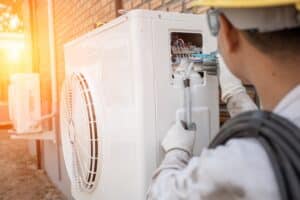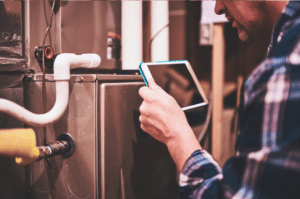When the desired temperature has been reached, your furnace should automatically turn off. Ideally, this is how your thermostat and furnace work together. If you find that your furnace has reached the desired temperature but it still continues to run, this indicates a problem that you should look into immediately. A faulty furnace or blower will waste energy and increase your utility bills quite significantly. Before you call an HVAC professional, there are a few simple things that you may want to check for yourself.
Check the thermostat
It may be that, by accident, you have set your thermostat temperature too high, which is pushing your furnace to run for a longer duration to reach the desired temperature. Simply by resetting the temperature to a reasonable setting, or setting the furnace temperature to a desired level should automatically shut off the furnace as it reaches the specified temperature. Also, ensure that your thermostat is set to “Auto” and not “On”.
Check the air filters
Dirty or clogged filters restrict airflow. Although it is believed that a furnace’s filter ensures clean air circulating in your home, it is not entirely true. The furnace filter ensures that no dirt or debris is collected inside your furnace heat exchanger and other essential components. When airflow is restricted, the furnace takes longer, and works harder to provide the desired temperature in your house.
Inspect ductwork for leaks
Another simple thing you can do is to check the ductwork for any leaky areas. It could be possible that all the hot air is being blown out in your attic or basement, which is ultimately wasted. Over time, the ductwork seals loosen up or open up, which allows hot air to escape and cold air to enter and circulate in your house.
Check the fuel supply
It may be that your furnace has been running for many hours, but not enough heat has been produced from it. An interruption in the fuel supply can cause the blower motor to work continuously because it is not being able to convert fuel into heat.
Check the blower motor
The way this works is, first, the heat exchanger heats up, and then the blower motor (or fan) circulates household air over it to heat the air in your house. You should check if the vents are blowing hot air or cold air. If they are blowing cold air, then there may be an electrical wiring problem between your thermostat and your furnace. This would require professional help.
If this issue has been going on for quite a while and you’ve crosschecked the above points, it is best you contact an HVAC professional.
When the desired temperature has been reached, your furnace should automatically turn off. Ideally, this is how your thermostat and furnace work together. If you find that your furnace has reached the desired temperature but it still continues to run, this indicates a problem that you should look into immediately. A faulty furnace or blower will waste energy and increase your utility bills quite significantly. Before you call an HVAC professional, there are a few simple things that you may want to check for yourself.
Check the thermostat
It may be that, by accident, you have set your thermostat temperature too high, which is pushing your furnace to run for a longer duration to reach the desired temperature. Simply by resetting the temperature to a reasonable setting, or setting the furnace temperature to a desired level should automatically shut off the furnace as it reaches the specified temperature. Also, ensure that your thermostat is set to “Auto” and not “On”.
Check the air filters
Dirty or clogged filters restrict airflow. Although it is believed that a furnace’s filter ensures clean air circulating in your home, it is not entirely true. The furnace filter ensures that no dirt or debris is collected inside your furnace heat exchanger and other essential components. When airflow is restricted, the furnace takes longer, and works harder to provide the desired temperature in your house.
Inspect ductwork for leaks
Another simple thing you can do is to check the ductwork for any leaky areas. It could be possible that all the hot air is being blown out in your attic or basement, which is ultimately wasted. Over time, the ductwork seals loosen up or open up, which allows hot air to escape and cold air to enter and circulate in your house.
Check the fuel supply
It may be that your furnace has been running for many hours, but not enough heat has been produced from it. An interruption in the fuel supply can cause the blower motor to work continuously because it is not being able to convert fuel into heat.
Check the blower motor
The way this works is, first, the heat exchanger heats up, and then the blower motor (or fan) circulates household air over it to heat the air in your house. You should check if the vents are blowing hot air or cold air. If they are blowing cold air, then there may be an electrical wiring problem between your thermostat and your furnace. This would require professional help.
If this issue has been going on for quite a while and you’ve crosschecked the above points, it is best you contact an HVAC professional.









